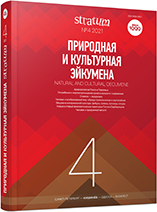Изучение археозоологической коллекции городища Ашна-Пандо в Среднем Посурье
A Study of the Archaeozoological Collection from the Ashna-Pando Hillfort in the Middle Sura Region
Author(s): Leonid A. Vyazov, Gulshat Sh. Asylgaraeva, Marat R. GismatulinSubject(s): History, Archaeology, Economic history, Ancient World, 6th to 12th Centuries
Published by: Издательский дом Stratum, Университет «Высшая антропологическая школа»
Keywords: Middle Sura region; Imenkovo culture; Great Migration Period; Early Iron Age; Bronze Age; archaeozoology;
Summary/Abstract: The article presents the results of processing of the archaeozoological collection from the excavations of the Ashna-Pando hillfort (Surskiy district of the Ulyanovsk region), carried out by P. D. Stepanov in 1949. The collection (2,760 bone fragments) belongs to three cultural layers identified at the site: the Fatyanovo-Balanovo culture of the Bronze Age, a specific local cultural group of the Early Iron Age and the Imenkovo culture of the late period of the Migrations era. It is the materials of the Migration period that are of the greatest interest. During that time, Ashna-Pando, in all likelihood, played the role of a local communal center — a place for meetings of the community. The collection of bones from the Imenkovo assemblage seems to reflect periodic joint meals rather than daily consumption. In general, the meat diet of the Imenkovo population, especially for the last period of the occupation of Ashna-Pando, was characterized by the increasing role of hunting for forest fauna, which, in combination with the finds of agricultural tools in Ashna-Pando as well as in other settlements of the Imenkovo in the Sura region, reflects the decisive role of slash-and-burn farming in the economic system.
Journal: Stratum plus. Археология и культурная антропология
- Issue Year: 2021
- Issue No: 4
- Page Range: 125-140
- Page Count: 16
- Language: Russian
- Content File-PDF

